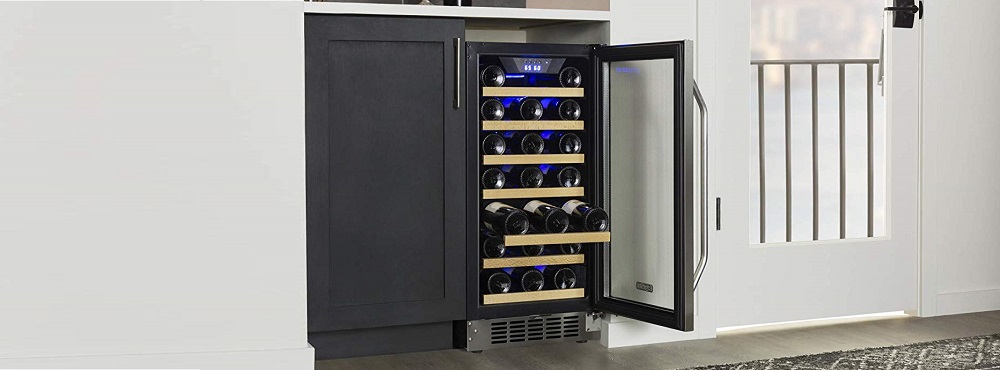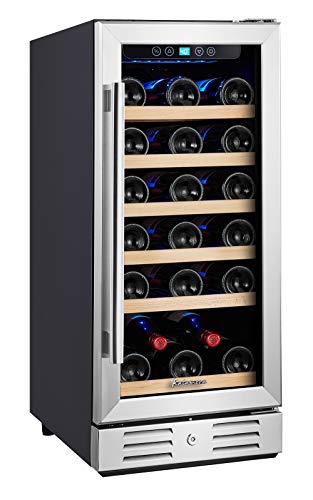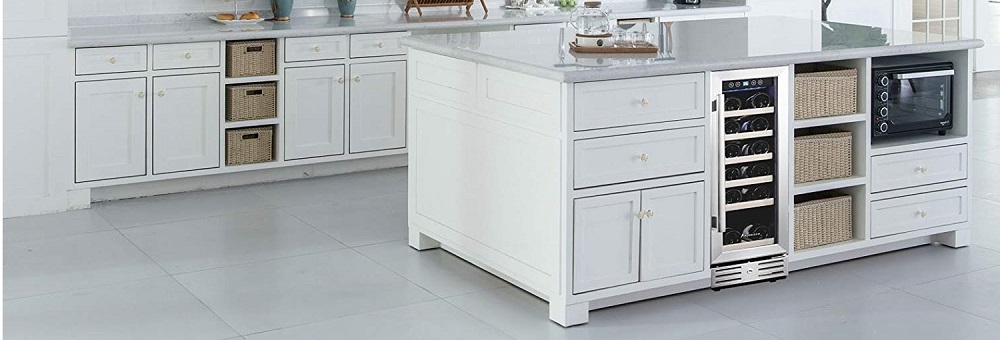
Wine coolers are awesome. They provide a safe, easy, and effective way of keeping your wine cooled to the adequate temperature. For this reason, wine coolers are incredibly popular, and for any wine connoisseur – or, well, anyone who enjoys a good glass of wine every so often – a wine cooler is an absolute necessity.
However, two types of wine coolers are available on the market. Freestanding wine coolers, which are very popular, and built-in wine coolers, which are also quite popular, but not as much as freestanding wine coolers. These two wine coolers serve the same primary function – that of cooling your wine to the temperature it is meant to be served at – but they do so in a slightly different way.
In this buying guide, you’re going to learn all about built-in wine coolers. And, you are also going to learn all about freestanding wine coolers, because for you to understand what a built-in wine cooler is, and what it does, you need to understand what a freestanding wine cooler is.

Once we’ve gone through the two different types of wine coolers, you are then going to learn all about the various features, attributes, and considerations that will, inevitably, come up, when you are searching for the best built-in wine cooler. These are things that will significantly affect your overall experience with the wine cooler, which is why it is so essential that you consider these aspects and consider them. If you don’t do that, you might end up with a built-in wine cooler that isn’t up to par with what you want, or need.
With that being said, let’s define what a freestanding wine cooler is, and then we’re going to explain what a built-in wine cooler is.
This website is supported by readers. As an Amazon Associate we earn from qualifying purchases.What Is A Freestanding Wine Cooler?
A freestanding wine cooler is a type of refrigerator/cooler that is designed to store wine of all sorts. Now, with a wine cooler, unlike a regular fridge, you usually have access to settings that enable you to change the temperature, so that the wine cooler can properly accommodate your wine, and the temperature, as well as the humidity level, that it needs. A regular fridge is unable to do this, more often than not.
Essentially, a freestanding wine cooler serves as a cooler that keeps your wine at the right temperature, and the proper humidity level. But, that definition doesn’t define the “freestanding” part of the “freestanding wine cooler”, it only defines the “wine cooler” aspect.

On the sides or the rear, of a freestanding wine cooler, you will notice ventilation shafts. These ventilation shafts serve as a way of conducting air so that it can remain at the proper temperature, without overheating. Without these vents, the wine cooler would overheat, and this would affect the quality of the wine.
Due to the placement of these vents, a wine cooler must be positioned in a space where it isn’t surrounded by walls and other surfaces. Instead, it needs to stand on its own, freely, in a space that is open, so that it can conduct air into the wine cooler, through the sides, and the rear. Most freestanding wine coolers are also quite large, which means they can store more wine but may be harder to find the right place for.
So, What Is A Built-In Wine Cooler?
A built-in wine cooler is quite similar to a freestanding wine cooler. It serves the same purpose, keeping your wine cooled at the adequate temperature and humidity level, and they tend to look the same, on a basic aesthetic level. However, two very distinct differences separate built-in wine coolers, from freestanding wine coolers.
Instead of the ventilation being located on the sides of the wine cooler, or the rear, the ventilation is located right on the bottom, in the front. This is so that the wine cooler can pull in air that is in front of it, rather than pulling air from the sides and the back.
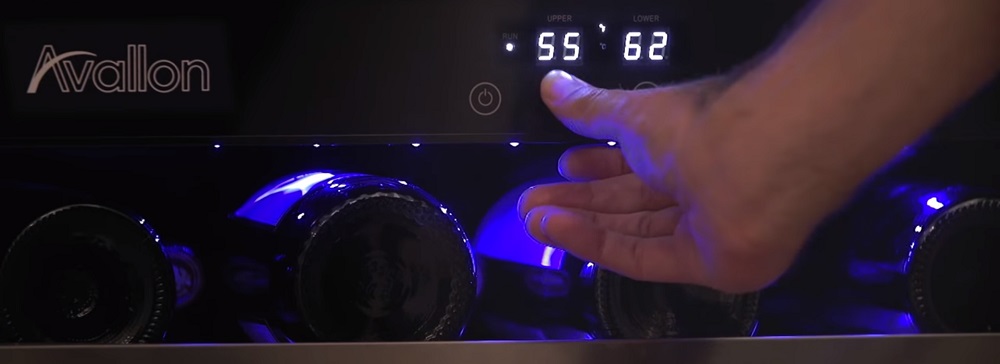
The other difference is that built-in wine coolers are quite a bit smaller, and this is because they have been designed to fit underneath the countertops in your kitchen, and other types of spaces. That’s also why they have the ventilation right on the front, instead of located all around the wine cooler itself. Because of this, they are a lot smaller than freestanding wine coolers, they are easier to move around, and you have more choices when it comes to where you put the wine cooler.
Ultimately, built-in wine coolers are great because of their mobility, small form-factor, and the fact that they are a lot easier to maintain, as a result of their simple ventilation and small size.
What Do I Need To Consider And Look For, When Searching For A Great Built-In Wine Cooler?
Now that you are aware of the differences between the two types of wine coolers, it’s time to look at the specific factors and attributes, as well as considerations, that will directly, and greatly, affect the built-in wine cooler that you buy, and the experience that it gives you.
Where Are You Going To Be Placing Your New Built-In Wine Cooler?
Before you buy your built-in wine cooler, it is imperative that you know – or, at the very least, have a good idea – where, exactly, you are going to be placing this wine cooler. Now, fortunately, built-in wine coolers are quite nice, due to their small size and form-factor, which means you can place them in quite a few spaces, and you don’t need to worry about having enough space for ventilation on the sides and the back.
Most built-in wine coolers will be stored underneath kitchen countertops. If that is what you intend to do, make sure you know where it will go, and it’s also recommended to know the measurements, as well, so that you can make sure you don’t buy a built-in wine cooler that is too big for that space. Or, on the other hand, if you intend to store the built-in wine cooler in a space that isn’t underneath a countertop, make sure you know where that space is.
If you don’t know where it is going to be located, it may be a challenge finding a good space. But, if you do know, then it’s only a matter of placing it there, once you buy the built-in wine cooler.

What Is The Storage Capacity Of The Built-In Wine Cooler?
One of the most important questions to ask is “What is the storage capacity of this built-in wine cooler?” This information should be on the store page of the built-in wine cooler that you are looking at, and it is a very important consideration, for a few reasons.
First off, you need to consider the amount of wine that you own. If you own a lot of wine – say, thirty-bottles – then you are going to need a built-in wine cooler with, at the bare minimum, a capacity of thirty-bottles. But, for many people, they will need to buy a built-in wine cooler with a greater capacity, such as a capacity for forty-bottles. And this is because many people intend to build their wine collection, as they go. They aren’t going to stick with owning thirty-bottles of wine. They’re going to add more wine to the collection.
Perhaps, you intend to do the same. And if that is the case, then you need to consider, as well, a built-in wine cooler that has a greater capacity than that of your current wine collection.
The next thing you need to consider is the size of the built-in wine cooler. Naturally, a built-in wine cooler with a greater storage capacity will be larger than other built-in wine coolers. So, make sure to consider your wine collection, the storage capacity of the built-in wine cooler itself, and, of course, just how large the built-in wine cooler is, and how, exactly, that is going to affect how and where you store the built-in wine cooler.

Do You Want A Built-In Wine Cooler With Multiple Cooling Zones?
When looking at wine coolers, you’re going to encounter a term known as “multiple cooling zones”. There are quite a few built-in wine coolers that have multiple cooling zones, and these cooling zones have many advantages. But, of course, this begs the question, what are cooling zones, and what advantages does having multiple cooling zones bring?
So, cooling zones are, essentially, spaces within the wine cooler that operate at their specific temperature. Most built-in wine coolers consist of a single cooling zone. You put every bottle of your wine into this single cooling zone, and every bottle of wine within that cooling zone is cooled at a specific temperature.
However, with multiple cooling zones, multiple spaces within the wine cooler have their specific temperatures. As a result of this, you can cool different bottles of wine at different temperatures, all within the same wine cooler.
Here’s the thing, some wines need to be served at one very specific temperature. Other wines need to be served at another specific temperature. If you have a bunch of different wines, that each require different temperatures in order to be served properly, then you can’t all store them within a single cooling zone, instead, you are going to need to store those wines in different cooling zones, so that they can be stored at the proper temperature.
With multiple cooling zones, you can do this, but with a single-zone built-in wine cooler, you don’t have this ability.
There are single-zone built-in wine coolers, as well as dual-zone and triple-zone built-in wine coolers. But, those are a bit rarer.
Ultimately, this one depends on the types of wine that you have, and the temperatures that they require, and your tastes. For some people, a single-zone built-in wine cooler is more than adequate. For others, they’d rather have a dual-zone built-in wine cooler.
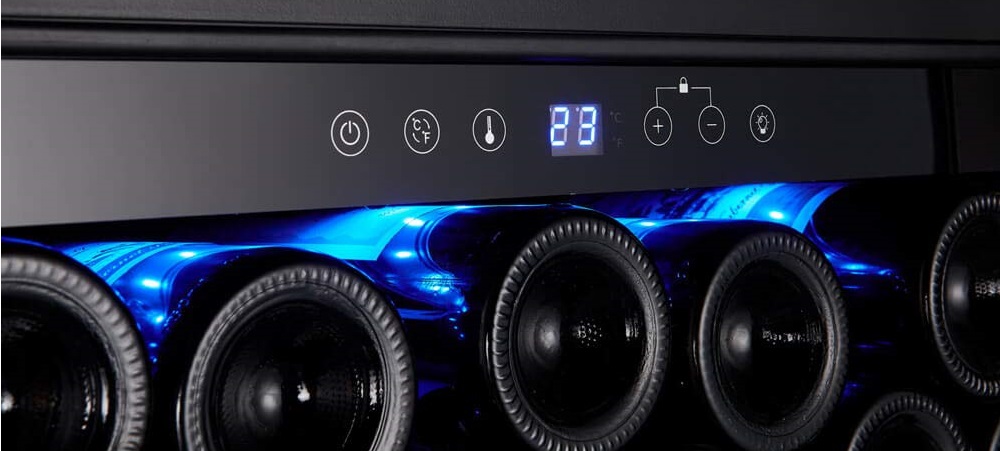
What Type Of Cooling Method Does The Built-In Wine Cooler Use?
In general, there are two types of cooling methods that you will find, when searching for built-in wine coolers.
The first cooling method is that of compressor cooling. Compressor cooling is very popular, and a bit more affordable, when it comes to the initial investment. Most kitchen refrigerators use compressor cooling.
With compressor cooling, you can cool a significant amount of wine, at any one time. And, if the environment the wine cooler is in changes drastically, when it comes to the temperature, with compressor cooling, the temperature within the wine cooler will remain the same. However, they tend to use a lot of energy.
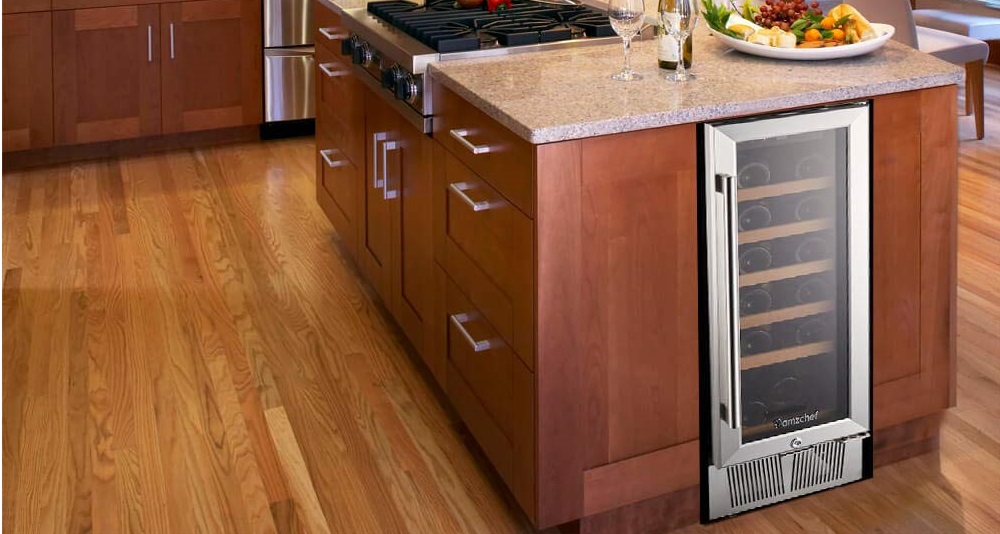
The second cooling method is thermoelectric cooling. Thermoelectric cooling uses less energy than compressor cooling, and they are also a lot quieter. However, they are designed for much smaller built-in wine coolers, and they can’t adequately cool larger wine collections.
This means that if you have a large wine collection, compressor cooling is the ideal choice. Along with that, thermoelectric cooling is greatly affected by the temperature outside of the built-in wine cooler itself. This means that if you are living in a really hot climate, the built-in wine cooler will be affected by that.
Conclusion
Wine coolers are fantastic! And built-in wine coolers are amazing, and they make storing your wine at the right temperature very easy and very simple. With the right built-in wine cooler, storing your wine is no problem at all.
By following this guide, and considering the questions that we have illustrated, you will have no issues finding the best built-in wine cooler for yourself. Remember to consider all of the questions we brought up, and to be thorough in your search, while considering your own needs.
